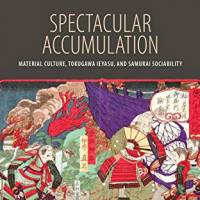In "Spectacular Accumulation" Morgan Pitelka relates the thrilling interactions between three "unifiers" of Japan in the tumultuous decades of the late 16th century and early 17th century. This trio of warlords includes the bloodthirsty Oda Nobunaga, the vainglorious Toyotomi Hideyoshi and Tokugawa Ieyasu who triumphed at the blood-soaked 1615 siege of Osaka Castle.
Spectacular Accumulation, by Morgan Pitelka
256 pages
University of Hawaii, Nonfiction.
Despite the power struggles of the era, Nobunaga, Hideyoshi and Ieyasu were also concerned with seemingly humble objects: from tea caddies used in tea ceremonies to hunting falcons. Pitelka argues that these objects — including thousands of enemy heads collected as trophies by the warlords — were essential to demonstrate the unifiers' power and, as some of the artifacts were previously owned by aristocrats, to provide them with a lineage that they did not otherwise possess. Perhaps these objects were also an external representation of a desperate desire for self-preservation.
What stands out about the three warlords is not their avarice — there seems little in the way of worldly indulgences — but their Spartan aesthetic. Some discussion of the influence of Buddhism (and particularly Zen) in shaping the beliefs and appetites of Japan's warrior class might also have been beneficial.
Most gripping is the story of Ieyasu, who went from having to organize the ritual suicide of his own son (on Nobunaga's orders) to becoming, 20 years later, the psychological master at turning his opponents' allegiances. More interesting than the tea caddies is the psychological evolution evident in his fascinating life story.


















With your current subscription plan you can comment on stories. However, before writing your first comment, please create a display name in the Profile section of your subscriber account page.